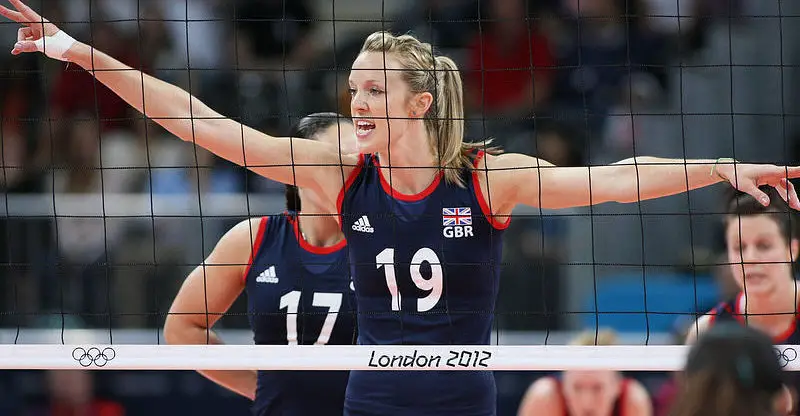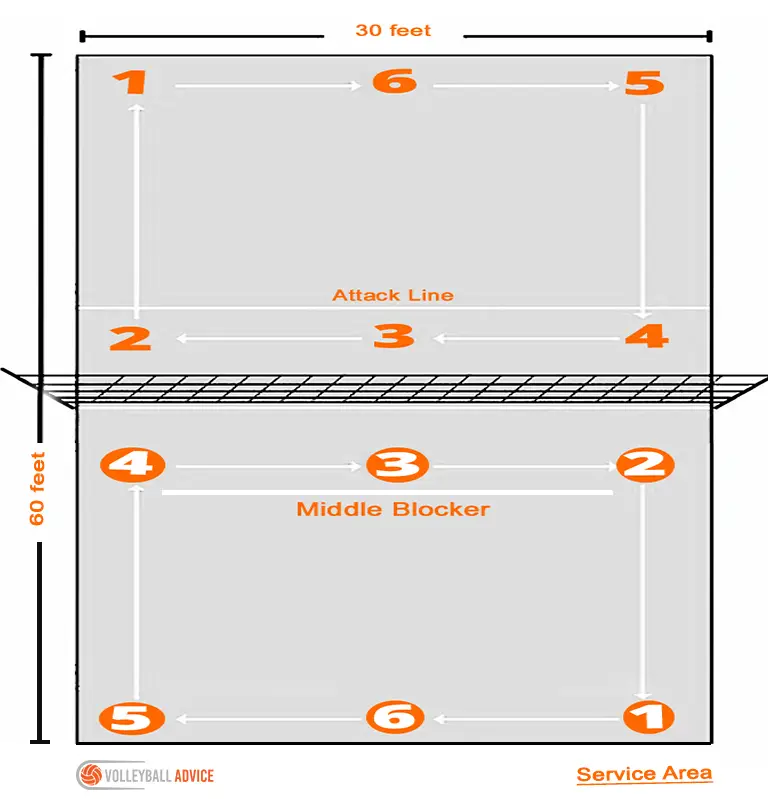Middle Blocker In Volleyball: What Is It & How To Be Good
The middle blocker position in volleyball controls the net.
Stereotyped as a position that only tall people can play, in reality, this position has been played by almost every player at one point or another. In men’s volleyball especially, most new players start out playing middle until they discover their favorite position and transition into that.
The truth is, you don’t have to be tall to play middle blocker – but you do need to be able to jump. Middle blocker is all about blocking, and having a strong jump to consistently reach over the net is key to its success.
Essentially, the middle blocker is both the stopping force that blocks the opposing team’s attack and the unstoppable force of their own fast attacks that seem to come out of nowhere.
In this article, I’ll be discussing what makes the middle blocker – the position I played for most of my volleyball career – great. Let’s take a look!
What Is A Middle Blocker In Volleyball?
A middle blocker exists to control the net. This can either be through their attacks as unstoppable, hard to react-to “quick” tempo spikes, or through sheer height and overwhelming blocking ability.
The mantra of middle blockers is: “Always Be Jumping”.
A middle blocker who isn’t jumping isn’t above the net isn’t controlling the net. https://thelyrically.com/
Whether jumping for hitting or blocking, the middle blocker is the player in the game who spends the most time in the air. Because of this, they need excellent conditioning and stamina to immediately transition from one block to another and react to tempo changes in the opposition’s attack.
As a player who rarely passes, the only effect you have on the game as a middle is how you control the net. Commit to your blocks and really go for those rare, few sets that you receive from the setter, because the middle quick is a notoriously tricky set for inexperienced players and some setters will avoid it at all costs.
The pass often determines whether you get set or not, and how far the setter has to step away from the net makes a massive difference in your effectiveness as a hitter.
The obvious downside to this is that it’s completely out of your control. As a non-passer, the middle relies on their team more than any other position in the game. Even if you don’t get set, using your approach jump every time will make the block have to consider you as a threat and lessen the stress on your wing spikers.
Ultimately, the middle blocker is what’s known as a “multiplier”.
With a good team and decent pass, the middle can be allowed to dominate with spikes and rack up the points, freeing the wing spikers to hit as the block is forced to deal with the quick tempo middle hits or risk losing yet another point. In short, you become an unstoppable force, multiplying your team’s points tenfold.
On the flip side, it can be very challenging to succeed as a middle with a below-average team or pass.
You might never get set despite approaching properly every time, and the defense ends up ignoring you, resulting in your wing spikers getting totally shut down.
Incredibly, some great setters might deliberately avoid setting you altogether.
Yikes.
Although this can be disheartening, stay resolute in the knowledge that your position is important. Talk to your team and try to work out any problems with your setter; remember, a good relationship with the setter is even more important for middles than other hitters!
Keep jumping, focus on your block, and your time will come.
How To Be A Good Middle Blocker
The middle blocker is primarily a front court position (positions 4, 3, 2).
While they rotate to the back row (positions 1, 6, 5) to serve just like everyone else, after their service points are concluded they switch out with a libero. This is to cover the common middle blocker weakness of being a poor passer, which is understandable given the average height of middles.
Make sure to stay aware when you’re the middle rotated off the court for the libero. When the other middle goes back to serve, you need to be ready to run on and switch back with the libero since it’s illegal for them to play front row.
Middle blockers are the center of the blocking defense in the front row, and occupy rotational position 3 on court. This means that even if they start in 4 or 2, they will switch with the wing spikers after the ball is served to play through the center. This allows them to be part of as many blocks as possible across the width of the net.
Rules For Middle Blockers
There are a couple of easy rules that all middles should know:
First, you are allowed to block across the top of the net as far as you like when it’s the third ball for the opposing team, which usually means they will be spiking.
Be careful not to touch the ball before it’s hit, however, or the net, as both will result in a loss of point for you!
Second, if a ball is crossing over to your side of the net, you must wait until it is on your side before spiking it down (or passing, if you wish).
Third, it is illegal to step under the net.
However, even if the rest of your body is under the net on the other side of the court, as long as one or both of your feet are on your side then it is allowed.
Knowing these rules and the role you have to fulfill will make you a better middle blocker overall.
The Middle Blocker Position – 4 Marks Of A Great Player
Athletic Ability
It is the middle blocker volleyball position in volleyball where natural athletic ability is the most important. A libero may have excellent ball handling skills and an exceptional reading of the game, while a setter may also possess the same attributes, but for a middle blocker being tall is paramount.
However, don’t think that the natural gift of being tall is all that it takes to play this volleyball position well. No. A middle blocker also needs to possess an excellent vertical jump, perhaps even more so than outside and opposite hitters.
This ensures that the player can block attacks and get above the defender’s blocks to meet the ball at a high point at a high percentage.
Game Reading Ability
A middle blocker must be able to read the game well by anticipating which player is going to hit the ball and where it will be hit to. Players who excel in this position know just how important preparation before the game is.
For example, during the warmup the player should learn the opposition players’ tendencies, such as:
- Is the player short or tall?
- Does the player possess quickness or is he slow?
- What is the player’s vertical jump like?
- What is the player’s weaknesses and how can they be exploited?
During the actual game, a middle blocker may then start taking note of other things, such as whether a certain player is a power hitter or what their favorite shot may be?
Top middle blockers even go beyond this by gaining more vital insight by noticing clues that others may not readily notice. These may include looking at a hitter’s shoulder position or into their eyes to see where they are eyeing up hitting the ball to.
All in all, a middle blocker who sets themselves apart from others plays the game smartly and thinks about every way in which they can get an edge, and often it is down to their reading of the game and not how necessarily how they physically play the game.
Communication
Good middle blockers are constantly communicating with their teammates, particularly the back-row players. Players who play on the back-row usually have a better view of everything that is going on out there than those who play at the net, so invaluable insight can be gained from them.
As stated above, the ability to read the game is also key, so a middle blocker may ask their teammates what tendencies, strengths and weaknesses of the opposition they have picked up and how best to exploit them.
Alertness
It goes without saying that middle blockers should always be alert out there on the court. Of course, those who play in this position need to watch the ball at the net, but what we also mean is that a middle blocker should watch how the play unfolds, particularly the pass.


